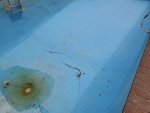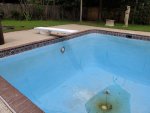- Jul 21, 2013
- 52,434
- Pool Size
- 35000
- Surface
- Plaster
- Chlorine
- Salt Water Generator
- SWG Type
- Pentair Intellichlor IC-60
I was told by a geologist that having hairline cracks is common in my part of the country.
The cracks in the pics are not hairline cracks. When you have a crack with a gap it is not hairline. A hairline crack looks like a pencil mark.



